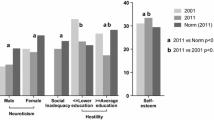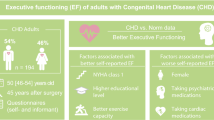Summary
To determine whether preoperative psychological testing in children with cyanotic heart disease could provide an accurate estimate of adult performance, we studied 21 subjects (mean age, 30.3±4.8 years) who had undergone surgical repair for tetralogy of Fallot between 1958 and 1966 (mean age, 8.7±3.9 years); 17 received childhood preoperative testing (mean age, 8.9±4.2) and four had early postoperative testing. Follow-up psychological tests administered in 1983 included Wechsler Adult Intelligence Scale Revised, Jackson Personality Research Form E, Rosenberg Self-Esteem Scale, and a questionnaire-interview on educational, occupational, and psychosocial status. Adult IQ (x=93.4±15.6) and child IQ (x=97.5±14.6) scores were highly correlated (r=0.87,p<0.01), revealing considerable stability across 22.3±2.2 years. On 17 of 22 Jackson personality scales, the subjects (S) were within the normal range. Scoring below the 16th percentile were 11/21 S on intellectual curiosity, 9/21 S on adaptability to change, and 8/21 S on leadership skills. Scoring above the 84th percentile were 8/21 S on harm avoidance and 8/21 S on giving nurturance to others. Univariate one-way ANOVAs indicated that those subjects with the higher IQ scores had the higher incomes, job levels, and educational attainments. We conclude that the results of perioperative psychological testing in children with tetralogy of Fallot are congruent with postoperative adult intellectual and psychosocial status.
Similar content being viewed by others
References
Blalock A, Taussig HB (1945) The surgical treatment of malformations of the heart in which there is pulmonary stenosis or pulmonary atresia.JAMA 128:189–202
Criteria Committee of the New York Heart Association (1964)Nomenclature and criteria for diagnosis of diseases of the heart and great vessels, 6th edn. Little, Brown, Boston
Ferencz C (1974) The quality of life of the adolescent cardiac patient.Postgrad Med 56:67–73
Fyler D (1980) Report of the New England Regional Infant Cardiac Program.Pediatrics [Suppl]65:375–461
Garson A, Williams RB, Reckless J (1974) Long-term follow-up of patients with tetralogy of Fallot: physical health and psychopathology.J Pediatr 85:429–433
Gersony WM, Malm JR (1973) Late results of repair of tetralogy of Fallot. In: Kirklin JW (ed)Advances in cardiovascular surgery. Grune and Stratton, New York, pp 17–27
Jackson DN (1974)Personality research form manual. Research Psychologists Press, Goshen NY
Kirklin JW, Barratt-Boyes BG (1986)Cardiac surgery: morphology, diagnostic criteria, natural history, techniques, results, and indications. John Wiley, New York, pp 765–766
Linde LM, Rasof B, Dunn OJ (1970) Longitudinal studies of intellectual and behavioral development in children with congenital heart disease.Acta Paediatr Scand 59:169–176
Manning JA (1983) Congenital heart disease and the quality of life. In: Engle MA, Perloff JK (eds)Congenital heart disease after surgery: benefits, residua, sequelae. Yorke Medical Books, New York, pp 347–361
Newburger JW, Silbert AR, Buckley LP, Fyler DC (1984) Cognitive function and age at repair of transposition of the great arteries in children.N Engl J Med 310:1495–1499
Nunnally J (1967)Psychometric theory. McGraw-Hill, New York
Pacifico AD, Bargeron LM, Kirklin JW (1973) Primary total correction of tetralogy of Fallot in children less than 4 years of age.Circulation 48:1085–1091
Pless IB, Roghmann KJ (1971) Chronic illness and its consequences: observations based on three epidemiologic surveys.J Pediatr 79:351–359
Robinson JP, Shaver PR (1973)Measures of social psychological attitudes. Institute for Social Research, Ann Arbor MI
Rosenberg M (1965)Society and the adolescent self-image. Princeton University Press, Princeton NJ
Rosenthal A, Behrendt D, Sloan H, Ferguson P, Snedecor S, Schork MA (1984) Long term prognosis (15–26 years) after repair to tetralogy of Fallot. I. Survival and symptomatic status.Ann Thorac Surg 38:151–156
Silbert A, Wolff PH, Mayer B, Rosenthal A, Nadas AS (1969) Cyanotic heart disease and psychological development.Pediatrics 43:192–200
Taussig HB, Kallman CH, Nagal, D, Baumgardner R, Momberger N, Kirk H (1975) Long-time observations in the Blalock-Taussig operation. VIII. 20–28 year follow-up on patients with tetralogy of Fallot.Johns Hopkins Med J 137:13–19
Wechsler D (1981)WAIS-R manual. Psychological Corp, New York
Author information
Authors and Affiliations
Rights and permissions
About this article
Cite this article
Shampaine, E.L., Nadelman, L., Rosenthal, A. et al. Longitudinal psychological assessment in tetralogy of Fallot. Pediatr Cardiol 10, 135–140 (1989). https://doi.org/10.1007/BF02081676
Issue Date:
DOI: https://doi.org/10.1007/BF02081676




